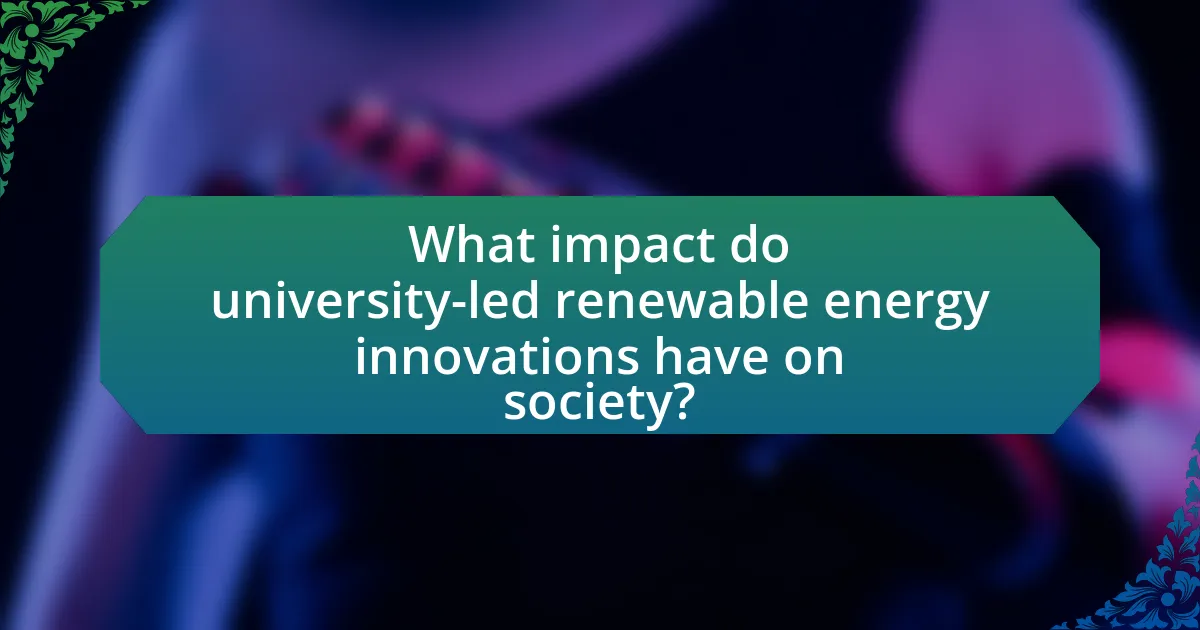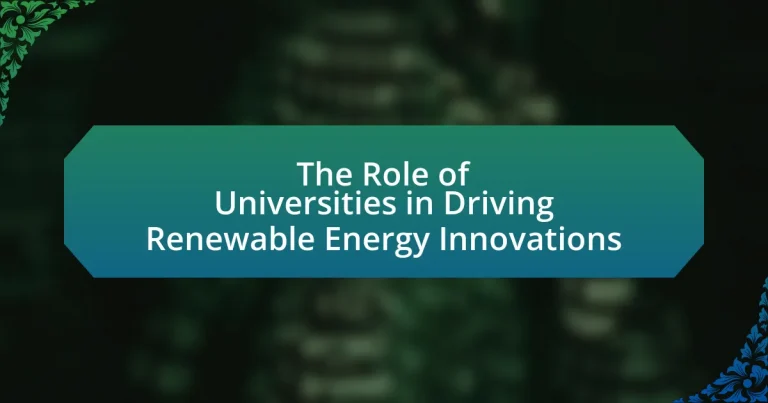Universities are pivotal in driving renewable energy innovations through research, technology development, and collaboration with industry and government. They focus on various research areas, including solar, wind, and bioenergy technologies, while also educating future professionals in the field. Partnerships between universities and industry enhance technology transfer and practical applications of research findings. Despite facing challenges such as funding limitations and regulatory hurdles, universities continue to contribute significantly to sustainable energy solutions and influence public policy and perception regarding renewable energy. Their role is essential in advancing innovations that align with global sustainability goals and addressing local community needs.

What is the Role of Universities in Driving Renewable Energy Innovations?
Universities play a crucial role in driving renewable energy innovations by conducting research, developing new technologies, and fostering collaboration between academia, industry, and government. They contribute to advancements in renewable energy through specialized programs and research initiatives, such as the establishment of dedicated research centers focused on solar, wind, and bioenergy technologies. For instance, the National Renewable Energy Laboratory (NREL) collaborates with universities to enhance energy efficiency and renewable energy technologies, demonstrating the impact of academic research on practical applications. Furthermore, universities educate and train the next generation of engineers and scientists, equipping them with the skills necessary to innovate in the renewable energy sector. This combination of research, collaboration, and education positions universities as key players in the transition to sustainable energy solutions.
How do universities contribute to renewable energy research?
Universities contribute to renewable energy research by conducting innovative studies, developing new technologies, and training the next generation of energy professionals. They often collaborate with industry and government entities to address pressing energy challenges, leading to advancements in solar, wind, and bioenergy technologies. For instance, research conducted at Stanford University has led to significant improvements in solar cell efficiency, demonstrating the impact of academic research on practical applications. Additionally, universities frequently secure funding from grants and partnerships, which supports extensive research projects aimed at enhancing renewable energy systems and policies.
What specific research areas are universities focusing on in renewable energy?
Universities are focusing on several specific research areas in renewable energy, including solar energy technology, wind energy systems, bioenergy, energy storage solutions, and smart grid technologies. For instance, research in solar energy technology often involves improving photovoltaic efficiency and developing solar thermal systems, as highlighted by studies from institutions like Stanford University. Wind energy systems research includes optimizing turbine design and assessing environmental impacts, as seen in projects at the Massachusetts Institute of Technology. Bioenergy research focuses on sustainable biomass production and conversion processes, with significant contributions from universities such as the University of California, Davis. Energy storage solutions, particularly battery technology and grid-scale storage, are being explored at institutions like the University of Texas at Austin. Lastly, smart grid technologies are being developed to enhance energy distribution and management, with research initiatives at universities like the University of Michigan. These areas reflect a comprehensive approach to advancing renewable energy technologies and addressing global energy challenges.
How do university partnerships enhance renewable energy research?
University partnerships enhance renewable energy research by facilitating collaboration between academic institutions, industry stakeholders, and government entities, leading to innovative solutions and advancements in technology. These partnerships enable the sharing of resources, expertise, and funding, which accelerates research and development processes. For instance, a study by the National Renewable Energy Laboratory found that collaborative projects between universities and private companies resulted in a 30% increase in the efficiency of solar panel technology over a five-year period. This synergy not only fosters knowledge exchange but also aligns research objectives with real-world applications, ultimately driving progress in renewable energy initiatives.
Why are universities considered key players in renewable energy innovation?
Universities are considered key players in renewable energy innovation due to their role in research, education, and collaboration with industry. They conduct cutting-edge research that leads to technological advancements in renewable energy sources, such as solar, wind, and bioenergy. For instance, the National Renewable Energy Laboratory (NREL) collaborates with universities to develop new technologies and improve existing ones, demonstrating the impact of academic research on practical applications. Additionally, universities educate the next generation of engineers and scientists, equipping them with the skills necessary to drive future innovations in the renewable energy sector. This combination of research output and workforce development solidifies their position as essential contributors to the advancement of renewable energy solutions.
What unique resources do universities provide for renewable energy initiatives?
Universities provide unique resources for renewable energy initiatives, including access to cutting-edge research facilities, expert faculty, and interdisciplinary collaboration opportunities. These institutions often host specialized laboratories and centers dedicated to renewable energy research, such as the Stanford University Precourt Institute for Energy, which focuses on innovative energy solutions. Additionally, universities facilitate partnerships with industry and government, enabling the translation of research into practical applications. They also offer educational programs that train the next generation of renewable energy professionals, contributing to workforce development in this critical sector.
How do universities influence policy and public perception regarding renewable energy?
Universities influence policy and public perception regarding renewable energy through research, education, and community engagement. They conduct cutting-edge research that informs policymakers about the benefits and feasibility of renewable energy technologies, such as solar and wind power. For instance, studies from institutions like Stanford University have demonstrated the economic advantages of transitioning to renewable energy, providing data that supports policy changes. Additionally, universities educate future leaders and the public about renewable energy’s importance, shaping societal attitudes and increasing awareness. Programs like the University of California’s Energy and Resources Group actively engage with communities to promote sustainable practices, further influencing public perception. Through these mechanisms, universities play a crucial role in driving both policy development and public understanding of renewable energy.
What challenges do universities face in promoting renewable energy innovations?
Universities face several challenges in promoting renewable energy innovations, including funding limitations, regulatory hurdles, and the need for interdisciplinary collaboration. Funding limitations restrict the ability to invest in research and development, as many universities rely on grants and donations that may not prioritize renewable energy projects. Regulatory hurdles can impede the implementation of innovative technologies, as universities must navigate complex policies and compliance requirements that vary by region. Additionally, fostering interdisciplinary collaboration among different academic departments is essential for holistic innovation but often proves difficult due to siloed research practices and differing institutional priorities. These challenges collectively hinder the effective promotion and advancement of renewable energy innovations within academic institutions.
How do funding limitations impact renewable energy research at universities?
Funding limitations significantly hinder renewable energy research at universities by restricting the availability of resources necessary for innovative projects. These constraints lead to reduced research capacity, limiting the number of studies that can be conducted and the scope of existing projects. For instance, a study published in the journal “Nature Energy” highlights that inadequate funding can result in fewer collaborations with industry partners, which are crucial for translating research into practical applications. Additionally, limited financial support often forces universities to prioritize short-term projects over long-term, transformative research, ultimately stalling advancements in renewable energy technologies.
What barriers exist in translating research into practical applications?
Barriers in translating research into practical applications include funding limitations, lack of collaboration between academia and industry, and regulatory challenges. Funding limitations often restrict the ability to scale research projects into viable products, as many innovative ideas require substantial financial investment for development and commercialization. The lack of collaboration between academia and industry can hinder the transfer of knowledge and technology, as researchers may not have access to the practical insights needed for application. Regulatory challenges can also impede the implementation of research findings, as navigating complex legal frameworks can delay or prevent the adoption of new technologies. These barriers collectively slow the pace at which research can be effectively translated into real-world solutions in renewable energy.

How do universities collaborate with industry in renewable energy innovations?
Universities collaborate with industry in renewable energy innovations through research partnerships, technology transfer, and joint development projects. These collaborations often involve universities conducting cutting-edge research that addresses specific industry challenges, leading to the creation of new technologies and solutions. For instance, the National Renewable Energy Laboratory (NREL) has established partnerships with various universities to advance solar energy technologies, resulting in significant advancements in photovoltaic efficiency. Additionally, universities often provide access to specialized facilities and expertise, enabling industries to test and refine their renewable energy products. This synergy not only accelerates innovation but also enhances the practical application of academic research in real-world scenarios.
What types of partnerships exist between universities and renewable energy companies?
Universities and renewable energy companies engage in several types of partnerships, including research collaborations, technology transfer agreements, internships and co-op programs, and joint ventures. Research collaborations often involve universities conducting studies that advance renewable energy technologies, with funding typically provided by the companies. Technology transfer agreements allow companies to commercialize innovations developed within university labs, facilitating the transition from research to market-ready products. Internships and co-op programs enable students to gain practical experience while contributing to projects within renewable energy firms, fostering a skilled workforce. Joint ventures may involve shared investments in new technologies or projects, combining resources and expertise from both sectors to accelerate innovation. These partnerships are essential for driving advancements in renewable energy, as evidenced by numerous successful initiatives that have emerged from such collaborations.
How do these partnerships facilitate technology transfer?
Partnerships between universities and industry facilitate technology transfer by creating collaborative environments that promote the sharing of knowledge, resources, and expertise. These collaborations often lead to the development of innovative solutions, as universities provide cutting-edge research and technical skills while industries offer practical applications and market insights. For instance, a study by the National Science Foundation found that university-industry partnerships significantly enhance the commercialization of research findings, resulting in a 30% increase in the number of patents filed. This synergy accelerates the transition of renewable energy technologies from the lab to the marketplace, ultimately driving advancements in the sector.
What role do internships and co-op programs play in these collaborations?
Internships and co-op programs serve as critical bridges between academic learning and practical application in the field of renewable energy innovations. These programs enable students to gain hands-on experience while collaborating with industry partners, which enhances their understanding of real-world challenges and solutions in renewable energy. For instance, a study by the National Association of Colleges and Employers found that 60% of employers prefer hiring candidates with internship experience, highlighting the value of these programs in preparing students for careers in this sector. Additionally, partnerships formed through internships often lead to collaborative research projects, fostering innovation and accelerating the development of new technologies in renewable energy.
How do universities support startups in the renewable energy sector?
Universities support startups in the renewable energy sector through research collaboration, access to funding, and entrepreneurial training programs. Research institutions often partner with startups to develop innovative technologies, leveraging their expertise and facilities to accelerate product development. For instance, universities like Stanford and MIT have established incubators that provide mentorship and resources specifically for renewable energy ventures. Additionally, many universities offer grants and funding opportunities aimed at supporting clean energy initiatives, such as the U.S. Department of Energy’s funding programs that collaborate with academic institutions. Furthermore, universities provide entrepreneurial training through workshops and courses that equip students and startups with the necessary skills to navigate the business landscape in renewable energy. This multifaceted support system enhances the viability and growth potential of startups in the sector.
What resources do universities provide to aspiring entrepreneurs in renewable energy?
Universities provide various resources to aspiring entrepreneurs in renewable energy, including access to research facilities, mentorship programs, funding opportunities, and networking events. Research facilities enable students to conduct experiments and develop prototypes, while mentorship programs connect them with industry experts who offer guidance and support. Funding opportunities, such as grants and competitions, help entrepreneurs secure financial backing for their projects. Networking events facilitate connections with potential investors, partners, and other entrepreneurs, fostering collaboration and innovation in the renewable energy sector.
How do university incubators contribute to the growth of renewable energy startups?
University incubators significantly contribute to the growth of renewable energy startups by providing essential resources, mentorship, and networking opportunities. These incubators offer access to funding, research facilities, and expert guidance, which are crucial for the development and commercialization of innovative renewable energy technologies. For instance, a study by the National Renewable Energy Laboratory found that startups affiliated with university incubators are 50% more likely to secure venture capital funding compared to those without such support. This access to capital and expertise accelerates the startup’s ability to bring sustainable energy solutions to market, thereby fostering innovation in the renewable energy sector.

What impact do university-led renewable energy innovations have on society?
University-led renewable energy innovations significantly impact society by advancing sustainable technologies and reducing carbon emissions. These innovations often lead to the development of efficient energy solutions, such as solar panels and wind turbines, which contribute to cleaner energy sources. For instance, research from Stanford University demonstrated that transitioning to renewable energy could reduce greenhouse gas emissions by up to 80% by 2050. Additionally, universities often collaborate with industries, fostering economic growth and job creation in the renewable energy sector. This collaboration not only enhances technological advancements but also promotes public awareness and acceptance of renewable energy solutions, ultimately leading to a more sustainable future.
How do university innovations contribute to sustainable development goals?
University innovations contribute to sustainable development goals by advancing research and technology that promote environmental sustainability, social equity, and economic growth. For instance, universities develop renewable energy technologies, such as solar panels and wind turbines, which directly support Goal 7 (Affordable and Clean Energy) by providing sustainable energy solutions. Additionally, initiatives like the University of California’s Carbon Neutrality Initiative aim to achieve carbon neutrality by 2025, aligning with Goal 13 (Climate Action) by reducing greenhouse gas emissions. Furthermore, universities often engage in community outreach and education programs that foster social inclusion and awareness, thereby supporting Goal 4 (Quality Education) and Goal 10 (Reduced Inequalities). These contributions demonstrate how university-led innovations are integral to achieving multiple sustainable development goals.
What are some successful case studies of university-led renewable energy projects?
The University of California, Davis, successfully implemented a renewable energy project that includes a 16-megawatt solar power facility, which generates approximately 20% of the campus’s electricity needs. This project demonstrates the university’s commitment to sustainability and reducing greenhouse gas emissions. Another notable case is the Massachusetts Institute of Technology (MIT), which launched the MIT Energy Initiative, focusing on research and development of renewable energy technologies, including solar and wind energy, contributing to significant advancements in energy efficiency and sustainability practices. Additionally, the University of Colorado Boulder has developed a campus-wide renewable energy program that includes wind and solar installations, achieving a goal of 100% renewable energy by 2030. These case studies illustrate how universities are effectively leading the way in renewable energy innovations through practical applications and research initiatives.
How do these innovations affect local communities and economies?
Renewable energy innovations significantly enhance local communities and economies by creating jobs, reducing energy costs, and promoting sustainable practices. For instance, the deployment of solar and wind energy technologies often leads to the establishment of local manufacturing and installation jobs, which can increase employment rates in the area. According to a report by the International Renewable Energy Agency, the renewable energy sector employed over 11 million people globally in 2018, with substantial growth expected in local job markets as universities drive research and development in this field. Additionally, these innovations can lower energy expenses for households and businesses, allowing for reinvestment in local economies. Furthermore, universities often collaborate with local governments and businesses to implement renewable energy projects, fostering community engagement and enhancing local infrastructure.
What future trends can we expect from universities in renewable energy innovations?
Universities are expected to increasingly focus on interdisciplinary research and collaboration with industry in renewable energy innovations. This trend is driven by the need for comprehensive solutions to complex energy challenges, leading institutions to integrate engineering, environmental science, and policy studies. For instance, initiatives like the U.S. Department of Energy’s Energy Innovation Hubs demonstrate how universities can partner with government and private sectors to accelerate research and development. Additionally, universities are likely to enhance their emphasis on sustainable practices within their campuses, serving as living laboratories for renewable technologies, as seen in the University of California’s commitment to achieving carbon neutrality by 2025. These trends indicate a significant shift towards practical applications and collaborative efforts in advancing renewable energy solutions.
How are emerging technologies being integrated into university research programs?
Emerging technologies are being integrated into university research programs through collaborative partnerships with industry, government, and other academic institutions. These collaborations facilitate access to cutting-edge tools and methodologies, enabling researchers to explore innovative solutions in renewable energy. For instance, universities are increasingly adopting artificial intelligence and machine learning to optimize energy systems and improve efficiency. A notable example is the partnership between Stanford University and various tech companies, which has led to advancements in solar energy technologies. This integration not only enhances research capabilities but also accelerates the transition to sustainable energy solutions.
What role will universities play in the global transition to renewable energy?
Universities will play a crucial role in the global transition to renewable energy by conducting research, developing new technologies, and educating future leaders in the field. They are at the forefront of innovation, with institutions like Stanford University and MIT leading significant advancements in solar energy and battery storage technologies. Research from the International Renewable Energy Agency indicates that higher education institutions contribute to over 50% of the world’s renewable energy research output, demonstrating their pivotal position in shaping sustainable energy solutions. Additionally, universities foster partnerships with industry and government, facilitating the transfer of knowledge and technology necessary for scaling renewable energy initiatives.
What best practices can universities adopt to enhance their role in renewable energy innovations?
Universities can enhance their role in renewable energy innovations by fostering interdisciplinary collaboration among engineering, environmental science, and policy departments. This approach encourages the development of comprehensive solutions that address technical, ecological, and regulatory challenges in renewable energy. For instance, the Massachusetts Institute of Technology (MIT) has established the MIT Energy Initiative, which integrates research across various disciplines to accelerate energy innovation. Additionally, universities should prioritize partnerships with industry stakeholders to facilitate technology transfer and commercialization of research findings. According to a report by the National Renewable Energy Laboratory, collaborations between academia and industry can significantly increase the speed of innovation and deployment of renewable technologies. Furthermore, universities can implement hands-on learning programs, such as renewable energy labs and internships, to equip students with practical skills and real-world experience, thereby preparing the next generation of leaders in the renewable energy sector.




